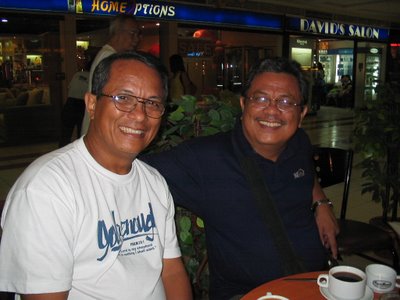By RUBELYN YAP
I always find Lake Mainit very enchanting and mysterious but when the Department of Tourism-13 conceptualized the Lake Mainit Grand Festival last month, it gave me the chance to visit the lake and the towns that surrounds it namely Jabonga, Mainit, Kitcharao and Tubay all in the provinces of Agusan del Norte and Surigao del Norte.
The towns
The first destination is Jabonga in Agusan del Norte, the site of the opening ceremony of all the activities for the grand fest namely Fluvial Parade, Baoto Race and the Lake Side Mountain Bike Challenge. Our group arrived in Jabonga's Great Lake Resort at around 4:00 p.m., looking at the lake a few steps from where I stand feels like your in paradise, its vastness would always makes me wonder how it is created.
Jabonga mayor Glicerio Monton, Jr. gave the group a chance to tour the lake through their 10-man capacity speedboat, without any vests I bravely ride and enjoy the scenery of the lake that surrounds me.
The wind in the area of Jabonga was so strong, the reason why windsurfing is good.
As we tour the area, many fishermen are waiting for the afternoon catch using their "Baoto" or Canoe made out of a hardwood tree known as Tugas and Magkuno.
Jabonga is an old settlement area that dates back to 1500's, known as Pueblo de Habongan (means shelter).
The town has 15 barangays, four in coastal, five are lakeside and six are near the mountain along the highway with a 25,000 population.
The town envisioned to be an Eco-Tourism destination in Caraga as it has trekking along Malimono range; diving in the Butuan Bay were seven dive sites are recently discovered; and kayaking, canoeing, windsurfing in the lake and cruising in the Kalinawan river, the lake's only outlet towards Butuan bay.
Jabonga has a very historic church that was built in the 1800's by the Jesuits and has a very beautiful, unique altar that is made of a hardwood tree.
Near the church lies the museum of the town and the old cemetery dates back to the Spanish time.
They have a very historical bell that is believed to be buried in the Kalinawan river and is one of the famous treasures of the town since it is a silver bell that was brought by the Spaniards from Spain.
To this very day, Jabonga is a disaster prone area since once a year, a flood will hit them that causes the lake to rise up to the side of the lakeside road that is more than 10 feet.
The second destination is Mainit town in Surigao del Norte where one can see the end of the lake for the fluvial parade and the awarding of the mountain bike challenge, then we proceeded to Kitcharao in Agusan del Norte for the turn over of the Mamanwa Cultural Center and the Lake Mainit Eco-Tourism Center and a fluvial parade.
The last destination is the town of Tubay in Agusan del Norte for the closing ceremony.
It is a small town facing Butuan bay and was once the center of commerce in the Spanish days since goods are transported in the area going to Lake Mainit using the "baoto".
Mayor Fidel Garcia said that the closing activity is significant as to the history of Tubay and Lake Mainit since Tubay is the only outlet of Lake Mainit through the Kalinawan river.
After the one day event that brought me to four towns, there is one thing that reminds me, a message I saw in one of the boats in the fluvial parade that states, "Ampingan nato an bahandi nan Danao na tagahatag nan ato kinaiyahan kay amoy tagapanginabuhian nan ato mga katiguyangan (We should take care of our treasure, the Lake, it is a gift of nature to us and it is where our ancestors earn their living)."
The Great Lake
As to the where the lake's name came from, locals believed in one legend as told by our homestay mistress 86-years old
Maria Mordeno Grana who heard the story from her grandparents who was once the Cabiza de Barangay in 1800s.
Long before, the area was inhabited by a supernatural couple named King Camig and Queen Ding with their animals.
The couple were very happy in their kingdom full of animals that every full moon, they had a merry-making.
In one occasion, the hornbills which were beside the king and queen, created a loud and boisterous sounds irritating the couple.
They then decided to leave the place at that instant in the middle of the special occasion. As supernatural as they were, the couple was able to bring their land and find a peaceful place where they can transfer their land.
In their hurry, a small portion of land was left behind and a deer (usa).
An unattended teapot boiling with water tilted, emptying its content and the golden ladle was thrown out.
When the royal couple was already in Butuan Bay going to Misamis, King Camig remembered a small piece of land to fetch it, reminding it to hurry and come back before the sun rises because something might happen.
Unfortunately, it was caught by the sunrise and true to its form, the land froze in its place and cannot move a distance anymore.
This land as they say is now called Tubay-Tubay because it only reached the Municipality of Tubay.
Right after the couple left, there was a heavy rainfall which made the vacated land filled with rain waters.
Apparently, it became a lake.
On the other hand, the water from the boiling teapot made the lake hot sometimes thus the lake was called LAKE MAINIT.
And the deer which was left behind became the islets that can be seen in the lake called Usa-Usa, at the closer look the islets looks like a deer.
It is believed that Camiguin Island was the new kingdom of King Camig and Queen Din.
Seen at an aerial view, the shape of the island is similar to the shape of the lake.
The flora and fauna of the areas are the same, birds are alike.
The lake is the fourth largest lake in the country with a surface area of 17,060 has a shoreline of 62.10 kilometers cuts across two provinces in the northern side of Mindanao-Agusan del Norte and Surigao del Norte.
It has a maximum depth of 223 meters enough to submerge a 57 story building, has 28 river tributaries and 87,072 hectares of total watershed areas. Jabonga shoreline has the largest lake shoreline at 22 kilometers while Kitcharao has 11.10 kilometers and Alegria has 8.40 kilometers.
A total of 31 barangays spread in these four municipalities depend on the lake for their food and livelihood.
The lake is most known for its rich fish resources, especially as a habitat of rare fish species such as puyo (climbing perch) and gabot.
The demand of "pidjanga" or goby is high as it is regarded a delicacy of both the local and visiting folks.
Other endemic fish species in the lake is freshwater eel (kasili), carp, hito, dalag, bugwan, shells, tilapia (nilotica) and other mollusks.
There are also wildlife species in the area surrounding the lake that includes cave bats, Philippine deer, wild boar and mighty hawks.
The freshwater flowers such as the pink and white Pagosi (sacred lotus) and the tabukali which are water hyacinth or water lily are abundant in the area.
The lake is ideal for spelunking, canoeing, scuba diving and windsurfing and there are lots of explored and unexplored islet caves, waterfalls and beautiful rock formation.
The lake is considered an oligotrophic lake which means its waters are transparent and have low density of plant life occurring at various depths and it is free of solid wastes.
Settlers
Before the Spaniards, came to the surrounding area of the lake, the place is settled by one of the oldest tribes in the Philippines, the Mamanwa.
The Mamanwas are dark-skinned and curly-haired people and are believed to be related to the Indigenous aboriginal people of Australia and is living in a hut they called "Sulirap", a hut where the ceiling is made of coconut leaves that reaches the ground and has a floor where they can sleep and only stood using a vine.
The tribe is now distributed along the northeast of Diwata mountains, the coastal areas of Surigao del Norte and in Mt. Hilong-Hilong after migrants occupied and dominated their ancestral domain.
The Mamanwas are traditionally nomadic hunter-gatherers, but most have since settled to fishing, trapping wildlife, gathering rattan or farming cassava, carrots, banana and corn.
They continue to preserve their traditional knowledge of plant species for herbal remedies and maintain some of their traditional values and social relations and believed that the kinaiyahan (environment) is their source of livelihood, their life and security for their children's future.
special thanks to Ms. Ruby Yap



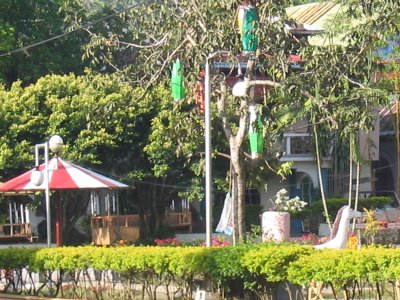
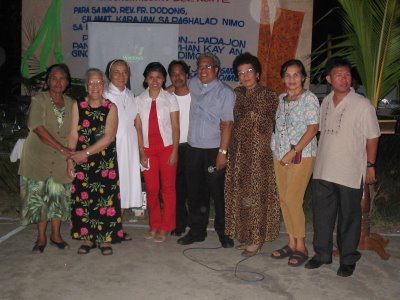

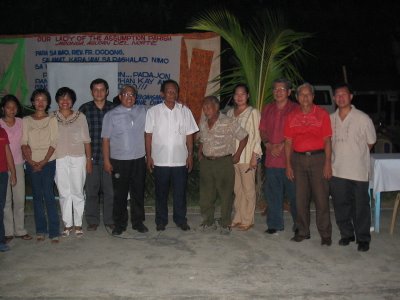
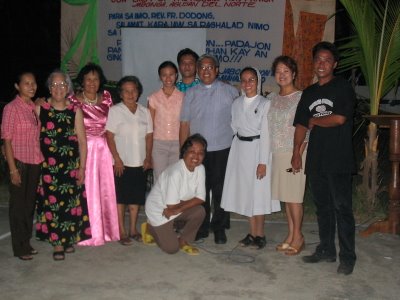

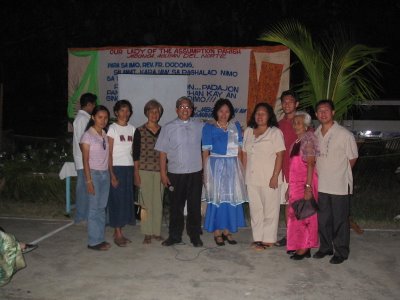

 A "pocket" of Habunganons had a mini-reunion cum agendaless meeting at Sta. Lucia East Malls in Cainta, Rizal with the Rosaleses: Efren and Belle with Ginbo and Yumi; Eman and Narcie (not seen in the pictures with Kaye and Jake); the Granas: Elvin; Bembot; Terence and Thel with Jombo in attendance.
A "pocket" of Habunganons had a mini-reunion cum agendaless meeting at Sta. Lucia East Malls in Cainta, Rizal with the Rosaleses: Efren and Belle with Ginbo and Yumi; Eman and Narcie (not seen in the pictures with Kaye and Jake); the Granas: Elvin; Bembot; Terence and Thel with Jombo in attendance.



